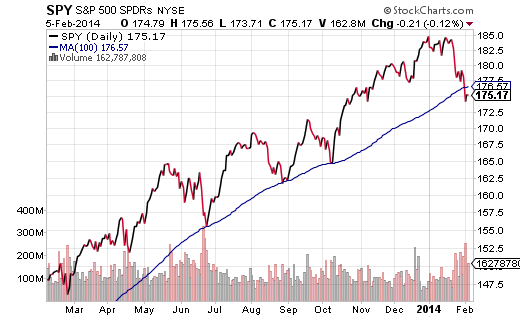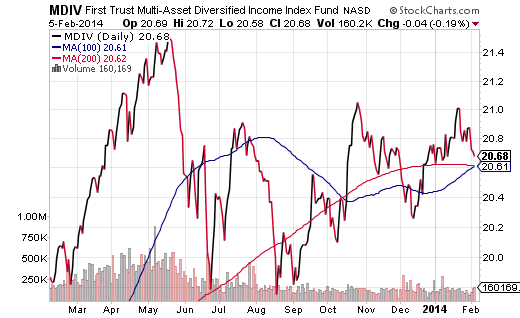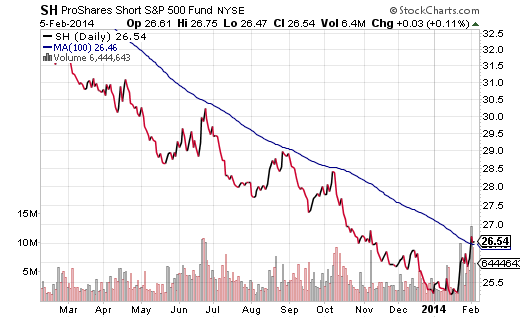If an economic data point came in much weaker than expected last year, the U.S. Federal Reserve’s monetary stimulus offered reason enough to buy stocks. Bad news served as good news. At the same time, when a data point exceeded expectations, the resilience of the American economy also inspired equity purchases. Good news served as good news. In fact, any news prompted additional risk taking in 2013. Flat corporate revenue? It will improve. Fed exit from quantitative easing (QE)? They are reducing their bond acquisitions because they see a strong economic expansion ahead.
Here in 2014, we’re seeing a near perfect reversal in market reaction; that is, bad news is being treated with venomous selling, while good news is being treated as an opportunity to get out at a higher price point. Granted, there have been flashes of buy-the-dip block orders from the institutional crowd. For the most part, however, a large percentage of folks are selling first and choosing to evaluate the prospects of the bull market later.
There are a variety of ways to deal with the current corrective activity. Conventional wisdom might suggest that you simply stick with your original asset allocation and ignore the increasingly volatile environment. Easier said than done, and not necessarily shrewd. I prefer an approach where one is insuring against a correction turning into something far more odious. In other words, I’d rather pay a small premium to protect against the possibility of a calamitous outcome, whether or not the calamity comes to fruition.
Here are three ways that an ETF investor can lessen the impact of a severe down market shock:
1. Short-Term Hedging. If you follow a variety of writers, analysts and commentators, you may have discovered what is often described as the intermediate trendline (a.k.a. 100-day moving average). When one of the largest publicly traded funds like the SPDR S&P 500 Trust (SPY) breaks below its 100-day, one might be wise to prepare for additional selling in broad market U.S. stock ETFs.

In tax-deferred accounts, one could choose to lighten up on some exposure to ETFs like iShares S&P 500 (IVV) or SPDR Dow Jones Industrials (DIA) through the use of stop-limit orders. For those who do not wish to realize gains in taxable accounts and/or who simply want to neutralize their long U.S. holdings without selling, an Inverse ETF can serve as a useful hedge. For example, an investor who is long the S&P 500 with a 20% allocation may wish to reduce the net long exposure to 15%. He/she might choose to buy a 5% allocation to ProShares Short S&P 500 (SH). The goal here is not to gain from a bearish prognostication, but rather, an exercise in minimizing loss by hedging against further declines in large cap U.S. equities. Remember, Inverse ETFs are daily compounding trading tools — not annual compounding assets. It follows that the longest span in which I might use an Inverse ETF is approximately eight to ten weeks.
2. Playing Defense. If anyone owned a crystal ball, he/she could tell you precisely how to make mad money. Without a crystal ball, one is left to interpret incoming information and respond accordingly. My interpretation since the first few weeks of 2014 is that increased S&P 500 VIX volatility, declining bond yields, equity fund outflows and rate-sensitive asset outperformance collectively flash a yellow warning sign. Under those circumstances, I am not looking to sell every asset, but instead, reduce the overall risks associated with participation.
A defensive mindset does not mean your portfolio is going to gain ground if the broader equity markets hit a full-blown 10% correction. It certainly does not imply that you will profit if a bear tramples across the field. Playing defense means losing less when market gyrations are making it difficult for an investor to sleep at night. You won’t gain as much if investors fall back in love with the riskiest stocks; then again, you will lose less if stocks continue drifting lower.
I have shifted toward a more defensive posture by allocating more to short-term high yield ETFs, Muni ETFs, Healthcare (XLV), Utilities (XLU) as well as Minimum Volatility ETFs such as iShares MSCI USA Minimum Volatility (USMV). For more specifics, explore one or more of the features below:
(A) In January 14th’s “3 Trends That Might Shock The Risk-On Mindset,” I discussed the flattening of the yield curve and using Bond ETFs that benefit from longer-dated maturities.
(B) In January 16th’s, “Against The Herd: Lower Rates Rather Than Higher Rates,” I explained why economic uncertainty during the tapering process would actually encourage investors to seek out safer havens, including Muni ETFs.
(C) In January 27th’s, “Ride The Risk-Off Trade Alongside Lower Interest Rates,” I talked about a shift towards traditionally safer equity ETFs like SPDR Select Health Care (XLV), SPDR Select Utilities (XLU) as well as iShares Telecom (IYZ).
3. Multi-Asset ETFs. If you believe like I do that the 10-year yield will be closer to 2.75% by year end, as opposed to the economist average of 3.4%, then you will probably be able to count on the income stream from multi-asset income producers like First Trust Multi-Asset (MDIV). Granted, MDIV has demonstrated a potential for erratic price movement of its own. Yet even when the 10-year spiked form 1.4% to 2.75% in 2013, MDIV’s drawdown of 8% was offset by an index yield close to 6.5% and capital appreciation when rates later stabilized. I would not expect MDIV to do much but offset losses if the 10-year yield does climb to 3.4%-3.5% by year’s end; that said, MDIV has the chance to repeat its performance of 10% annualized total return if 10-year yields remain contained below the 3.0% mark.

Disclosure: Gary Gordon, MS, CFP is the president of Pacific Park Financial, Inc., a Registered Investment Adviser with the SEC. Gary Gordon, Pacific Park Financial, Inc, and/or its clients may hold positions in the ETFs, mutual funds, and/or any investment asset mentioned above. The commentary does not constitute individualized investment advice. The opinions offered herein are not personalized recommendations to buy, sell or hold securities. At times, issuers of exchange-traded products compensate Pacific Park Financial, Inc. or its subsidiaries for advertising at the ETF Expert web site. ETF Expert content is created independently of any advertising relationships.

